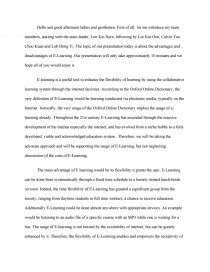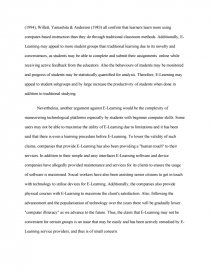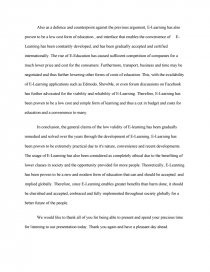Team Leader
Essay by imagine • July 26, 2013 • Essay • 1,190 Words (5 Pages) • 1,406 Views
Hello and good afternoon ladies and gentlemen. First of all, let me introduce my team members, starting with the team leader, Lim Kai Xern, following by Lor Kar Oon, Calvin Tan Choo Kuan and Loh Hong Yi. The topic of our presentation today is about the advantages and disadvantages of E-Learning. Our presentation will only take approximately 10 minutes and we hope all of you would enjoy it.
E-learning is a useful tool to enhance the flexibility of learning by using the collaborative learning system through the internet facilities. According to the Oxford Online Dictionary, the very definition of E-Learning would be learning conducted via electronic media, typically on the Internet. Ironically, the very usage of the Oxford Online Dictionary implies the usage of e-learning already. Throughout the 21st century E-Learning has ascended through the massive development of the medias especially the internet, and has evolved from a niche hobby to a fully developed, viable and acknowledged education system. Therefore, we will be taking the advocate approach and will be supporting the usage of E-Learning, but not neglecting discussions of the cons of E-Learning.
The main advantage of E learning would be its flexibility it grants the user. E-Learning can be done from systematically through a fixed time schedule to a loosely slotted lunch-break revision. Indeed, the time flexibility of E-Learning has granted a significant group from the society, ranging from daytime students to full time workers, a chance to receive education. Additionally E-Learning could be done almost anywhere with appropriate devices. An example would be listening to an audio file of a specific course with an MP3 while one is waiting for a bus. The range of E-learning is not limited by the availability of internet, but can be greatly enhanced by it. Therefore, the flexibility of E-Learning enables and empowers the receptivity of education throughout society, and thus granting the opportunity of learning to many people.
However, it is generally argued that the flexibility provided by E-Learning may be potentially abused due to the lack of discipline of students. The argument is genuine and accepted, as it is reasonable to be demotivated due to the lack of physical classes. Additionally students of E-Learning courses may feel isolated and alienated due to the lack of physical contact. However, this should not be confused with the efficiency of E-Learning, for it was statistically concluded by a nine-year survey of the research literature in training published by Fletcher and Tobias in 'Training and Retraining', commissioned by the American Psychological Society, and published in 2000, concluded that:
'Learners learn more using computer-based instruction than they do with conventional ways of teaching, as measured by higher post-treatment test scores.'
Additionally, the problem of demotivation and lack of discipline is a common issue shared by both E-learners and "classical" learners, and may only be solved by the learner themselves. Thus, although it is argued that the lack of motivation and discipline may be a problem of E-Learners, it is a problem shared by all learners, not only E-Learners, and has been statistically proven that the efficiency of E-Learning may actually remedy such issues for certain groups of people that may not enjoy traditional learning.
In addition to the arguments above, E-Learning may also serve as an improvement in learning styles of student groups when done together with physical classes. It is noted that E-Learning has reportedly fosters more interaction among students and instructors than in large lecture courses. This is by large because of the simplicity of interaction and the enabling of socially awkward students to express their thoughts. Specific studies
...
...



